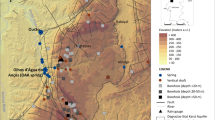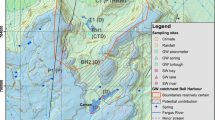Abstract
A conceptual model of the functioning of a complex coastal karst aquifer in southern Spain is presented. The system has well developed conduits below sea level and is connected to the Mediterranean Sea. It discharges through two conduits 12 m below sea level, 20 km apart. The Moraig conduit is the main outlet; the discharge to the sea is brackish. The Toix conduit only discharges to the sea during heavy floods and lets in seawater the rest of the time. During the 1999–2000 hydrological year, both conduits were monitored by flowmeters and electrical conductivity-temperature probes. On the basis of the collected data, the hydrological relationship between the functioning of the system and the sea was characterised. The conceptual model assumes the existence of a huge reservoir called an “aquifer reservoir” which is supplied by (1) freshwater from rainfall and (2) seawater flowing into the Toix conduit. In addition, during heavy rainfall events, fast infiltration brings considerable amounts of freshwater into the Moraig conduit. This is typical of a “by-pass” mechanism. Salinity and flow rates were simulated with the use of a rainfall-discharge and a rainfall-salinity model. The simulation of flow and salinity time series can be used for water management purposes.
Résumé
Un modèle conceptuel de fonctionnement d’un aquifère karstique côtier espagnol est présenté. Ce système est caractérisé par des conduits bien développés sous le niveau de la mer connectés à la Méditerranée. La vidange de l’aquifère s’effectue au travers de deux conduits profond de 12 m et distants de 20 km. Le conduit de Moraig est l’exutoire principal avec une évacuation d’eau saumâtre. Le conduit de Toix fonctionne en exutoire temporaire lors des fortes crues, sinon il absorbe de l’eau de mer. Durant le cycle hydrologique 1999–2000, les deux conduits ont été instrumentés à l’aide de courantomètres et sonde de conductivité électrique et température. Le fonctionnement hydrologique de ce système et ses relations avec la mer sont ainsi caractérisés à partir des données acquises. Le modèle conceptuel de fonctionnement suppose l’existence d’un vaste réservoir appelé « réservoir aquifère » alimenté par l’eau douce des précipitations et l’eau de mer qui pénètre par Toix. De plus, durant les fortes précipitations, l’infiltration rapide apporte un important flux d’eau douce à Moraig, fonctionnement caractéristique d’un « by-pass ». La salinité et les débits on été simulés à l’aide de modèles pluie-débit et pluie-salinité. La simulation des chroniques de débit et de salinité serviront ensuite à la gestion de la ressource.
Resumen
Se presenta el modelo conceptual de funcionamiento de un aquífero kárstico complejo situado al Sureste de España. El sistema tiene conductos bien desarrollados bajo el nivel del mar y está conectado con el Mar Mediterráneo. La descarga se produce a través de dos conductos situados 12 m por debajo del nivel de mar, separados 20 km. El conducto del Moraig constituye la salida principal y la descarga al mar es salobre. El conducto de Toix solamente descarga al mar durante fuertes tormentas y funciona como un sumidero de agua de mar en el acuífero el resto del tiempo. Durante el año hidrológico 1999–2000, ambos conductos fueron monitorizados mediante corrientímetros y sondas de Conductividad Eléctrica y Temperatura. En base a los datos obtenidos, se ha caracterizado la relación hidrológica entre el funcionamiento del sistema y el mar. El modelo conceptual asume la existencia de un reservorio inmenso denominado « Acuífero reservorio » que es alimentado por (i) agua dulce de la lluvia y (ii) entrada de agua de mar a través del sumidero de Toix. Además, durante eventos de lluvias fuertes, se produce una infiltración rápida que da lugar a gran cantidad de agua dulce en el conducto del Moraig. Se trata de un mecanismo típico de « by-pass ». La salinidad y las cantidades de flujo se simularon mediante el uso de un modelo de lluvia-descarga y salinidad-lluvia. La simulación de las series de tiempo de flujo y salinidad se pueden usar para la gestión de los recursos hídricos.













Similar content being viewed by others
References
Andreu JM, Cortés JM, Estévez A, Garcia-Sanchez E, Lopez-Arcos M, Pulido-Bosch A (2004) Benissa (Alicante, Spain), Cost Action 621, The main coastal karstic aquifers of southern Europe
Arfib B (2001) Etude des circulation d’eaux souterraines en aquifère karstique côtier : observations et modélisation de la source saumâtre Almyros d’Héraklion, Crète (Grèce). Thèse de Doctorat, Université Paris 6 [in French] (Study of groundwater flows in coastal karst aquifer: observations and modeling of the brackish spring Almyros of Heraklion, Crete (Greece))
Arfib B, de Marsily G (2004) Modeling the salinity of an inland coastal brackish karstic spring with a conduit-matrix model. Water Resour Res 40:W11506, doi:10.1029/2004WR003147
Arfib B, Ganoulis J (2004) Modélisation physique de l’intrusion d’eau de mer dans un aquifère karstique: cas de l’Almyros d’Héraklion (Crète). Comptes Rendus Géoscience 336(11):999–1006 [in French] (Physical modeling of seawater intrusion in a karst aquifer: case of Almyros d’Heraklion (Crete))
Arfib B, de Marsily G, Ganoulis J (2007) Locating the zone of saline intrusion in a coastal karst aquifer using springflow data. Ground Water 45(1):28–35
Aunay B, le Strat P, Duvail C, Dörfliger N, Ladouche B (2003) Méthode d’analyse géologique sur la karstification des Corbières orientales et influence des évènements néogènes (tortono-messiniens). In: Servat E, Najem W, Leduc C, Shakeel A (Ed.), Hydrology of the Mediterranean and semiarid Regions. IAHS, Montpellier, N° 278, pp. 124–129 [in French] (Geological analysis method on eastern Corbières karstification and impact of Neogene events (Turonian-Messinian)
Cortés JM, Antoranz A, Menvielle S, Ratsimandresy A, Cisneros J, Ramos S, Cabrera MC, Serrano V, Mateu J (2003) La intrusion marina en el sistema de cuevas Moraig-Toix. Un estudio para la recuperacion del acuifero de la depresion de Benissa (Marina Alta - Alicante). Sociedad Española de Espeleologia y Ciencias del Karst, No 4, 48–64. [in spanish] (Seawater intrusion in Moraig-Toix cave system. A study for water management of Benissa aquifer)
Drogue C (1989) Continuous inflow of seawater and outflow of brackish water in the substratum of the karstic island of Cephalonia, Greece. J Hydrol 106:147–153
Fleury P (2005) Sources sous-marines et aquifères côtiers méditerranéens. Fonctionnement et caractérisation. Thèse de Doctorat, Université Paris 6 [in French] (Submarine springs and coastal Mediterranean karst aquifers. Functioning and characterisation)
Ghyben B (1889) Nota in verband met voorgenomen putboring nabij Amsterdam, Inst. Ing. Tijdschr., La Hague [in German] (notes on the probable results of the proposed well drilling near Amsterdam)
Herzberg A (1901). Die Wasserversorgung einiger Nordsee Bäder. J. Gasbeleucht. Verw. Beleuchtungsarten Wasserversorg., 44: 815–819 et pp. 842–844 [in German] (Water supply of a few hydrothermal spas in the North Sea)
IGME-DPA (2001). Análisis y ordenación de recursos hídricos de la Marina Alta (Alicante). Alternativa y directruces 1a fase. Informe interno not edited [in Spanish] (Marina Alta (Alicante) water resources management and studies)
Maillet E (1905) Essais d’hydraulique souterraine et fluviale. Hermann, Paris, 218 p [in French] (Groundwater and river hydraulics)
Mangin A (1970) Contribution à l’étude d’aquifères karstiques à partir de l’analyse de courbes de décrue et de tarissement. Ann Spéléol 25(3):581–609 [in French] (A contribution to karst aquifer study based on the analysis of spring hydrographs)
Maurin V, Zoetl J (1965) Salt water encroachment in the low altitude karst water horizons of the island of Kephallinia (Ionian islands), Hydrologie des roches fissurées. AIHS, Dubrovnik, 2: 423–438
Nash JE, Sutcliffe JV (1970) River flow forecasting through conceptual models part I - A discussion of principles. J Hydrol 10(3):282–290
Pinault JL, Plagnes V, Aquilina L, Bakalowicz M (2001) Inverse modeling of the hydrological and the hydrochemical behavior of hydrosystems: characterization of karst system functioning. Water Resour Res 37(8):2191–2204
Plagnes V (1997) Structure et fonctionnement des aquifères karstiques. Caractérisation par la géochimie des eaux. Thèse de Doctorat, Université Montpellier II - Sciences et Techniques du Languedoc, Montpellier [in French] (Structure and functioning of karst aquifers. Characterisation by means of water geochemistry)
Potié L, Tardieu B (2005) Port Miou - Bestouan - Cassis (France) : summary of the balance. COST Action 621, Groundwater management of coastal karstic aquifers. Final report. 282–285
Réméniéras G (1986) L’hydrologie de l’ingénieur . 2ème éd. 1976, EDF et Eyrolles ed., Paris [in French] (Engineer hydrology)
VENSIM Software (1996–2007). Ventana Systems, Inc. http://www.vensim.com/ (July 2007)
Acknowledgements
We thank the reviewers for their interesting comments and discussion, and SIDMAR Bernhard Pack S.L. for providing the data collected at Moraig and Toix for this analysis.
Author information
Authors and Affiliations
Corresponding author
Rights and permissions
About this article
Cite this article
Fleury, P., Bakalowicz, M., de Marsily, G. et al. Functioning of a coastal karstic system with a submarine outlet, in southern Spain. Hydrogeol J 16, 75–85 (2008). https://doi.org/10.1007/s10040-007-0215-8
Received:
Accepted:
Published:
Issue Date:
DOI: https://doi.org/10.1007/s10040-007-0215-8




